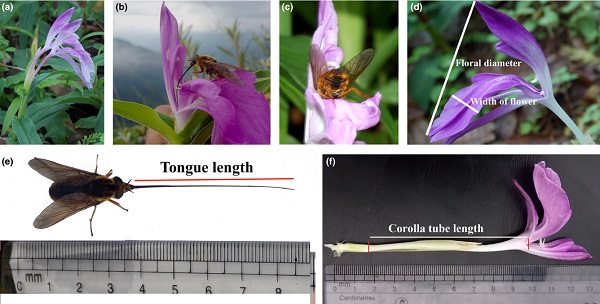
Pollinator-mediated selection is one of the key evolutionary forces underlying the remarkable diversity of angiosperm flowers. According to Darwin's hypothesis, selection on the pollinator favors longer proboscides to achieve easy access to the nectar, while selection on the plant favors longer corolla tubes, which ensure the pollinator's contact with the reproductive parts and thus maximize pollen transfer.
Dr. Babu Ran Paudel, a Nepalese postdoc of Xishuangbanna Tropical Botanical Garden (XTBG), and his supervisor LI Qingjun examined the interaction between an alpine ginger Roscoea purpurea (Zingiberaceae), and its obligate pollen vector, Philoliche longirostris (Diptera: Tabanidae). Their preliminary field observations indicated that inflorescence height, floral display area, and corolla tube length of R. purpurea, as well as proboscis length of P. longirostris, varied across the wide range of habitats in which the populations occur.
The researchers documented the pattern of trait variation in Roscoea purpurea and Philoliche longirostris across five populations. At each site, they quantified pollinator-mediated selection on floral display area, inflorescence height and corolla length of R. purpurea by comparing selection gradients for flowers exposed to natural pollination and supplemental hand pollination. The researchers also examined the reciprocal selection between R. purpurea and P. longirostris at two sites via the relationship between proboscis length and nectar consumption (fly benefit) and corolla length and pollen deposition (plant benefit).
The researchers found consistent, significantly positive relationships between plant fitness and corolla tube length at all sites. The corolla tube length was correlated with local fly proboscis length among the five sites. There was strong linear selection imposed by pollinators on corolla tube length at all sites, but no consistent relationship of fitness to inflorescence height or floral display area. They also found that selection between corolla length and proboscis length was reciprocal.
The study showed that obligate specialized pollination in R. purpurea allowed pollinator-mediated selection through female function to influence the evolution of corolla tube length. In turn, tube length appeared to impose selection pressure on the pollinator's proboscis length, thus creating a coevolutionary interaction between R. purpurea and P. longirostris. The results suggested that the reciprocal dynamics of the interaction occurred locally in individual populations, leading to a mosaic of local adaptation.
The study entitled “Coevolutionary elaboration of pollination-related traits in an alpine ginger (Roscoea purpurea) and a tabanid fly in the Nepalese Himalayas” has been published online in New Phytologist.

(a) Flowering individual of

86-10-68597521 (day)
86-10-68597289 (night)

52 Sanlihe Rd., Xicheng District,
Beijing, China (100864)

